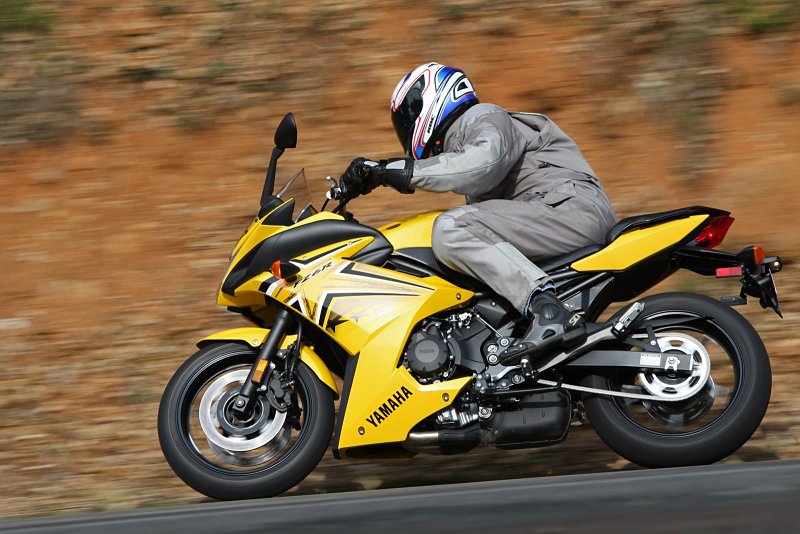
Motorcycle marketing guys nose around for new customers with the dedication of reef fish browsing the coral. Every niche, nook and cranny has to be investigated. And after extensive exploration of the US motorcycle market, here’s what Yamaha’s researchers discovered. Entry level riders want sporty styling.
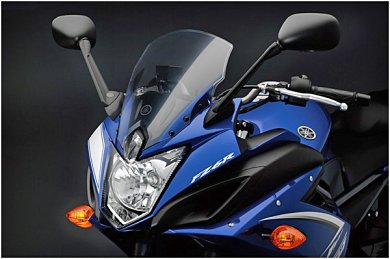
According to Yamaha’s research, wannabes prefer the full-fairing sportbike look to any other. Which is a bit of a problem, because Yamaha’s lower-rung 600-the FZ6-wears an abbreviated nosecone along with a pricetag-at $7,290-considered just a tad too high.
It’s also a problem for those picky buyers, because contemporary 600 supersport models flaunting the obligatory bodywork are priced close to ten grand these days, and that’s certainly not entry level. But now Yamaha believes it has the solution; a new bike based on an existing FZ6 engine, flaunting a full fairing and the requisite sport bike look, yet with cost taken out in various ways to pull the price down to around seven grand.
Some of the cost-saving strategies are obvious. The bike’s frame is a high-tensile steel-tube affair that uses the engine as a stressed member for good rigidity. Yamaha’s other 600s have expensive cast aluminum frames and swing arms. On the FZ6R, a plain steel swing arm mounts the rear wheel, and the brake pedal and gear lever are stamped and bent metal articles.
A conventional non-adjustable 41mm Soqi fork mounts the front wheel, while at the rear we find a monoshock unit (also from Soqi) with just a ramp-type, seven-step spring-preload adjuster. At the front wheel, twin-piston sliding-pin Akebono calipers grip the dual disc rotors rather than the opposed-piston units found on the FZ6 and other pure sport machines.
As an alternative to the 180-size hoop normally used on 600 sport bikes, there’s a 160/60-R17 tire from either Bridgestone or Dunlop at the rear of the machine, and both rubber formulations are of the sport-touring persuasion. But don’t be disheartened by the short list of somewhat less-expensive hardware, because Yamaha spent money in many of the right places on this new FZ6R.
Derived from the FZ6’s engine, the FZ6R’s inline-four acquires new crankcases in order to use a pull rod clutch release mechanism with a higher leverage ratio for lower lever effort. The camshafts and cylinder heads were reconfigured for a more flexible and torquey power delivery, with single intake-valve springs to reduce parasitic losses, and with a larger airbox and tapered inlet ports to improve cylinder filling at lower revs.
There’s a new 4-into-2-into-1 exhaust system tucked tightly under the bike’s mid-section to concentrate mass, and the instrument panel is a compact and contemporary analog and digital unit very much like that used on the considerably upmarket FZ1. The tachometer redline is at 11,500 rpm, proving that the retuned inline four can still spin, and the digital speed readout allows fast visual referral.
We found the improved low and mid-range response a welcome attribute in a motorcycle intended to fulfill various roles. There’s simply no need to spin the engine hard in normal urban situations, where the re-cammed and flowed cylinder heads and sophisticated Mikuni fuel injection provide smooth and satisfying pickup at moderate engine speeds.
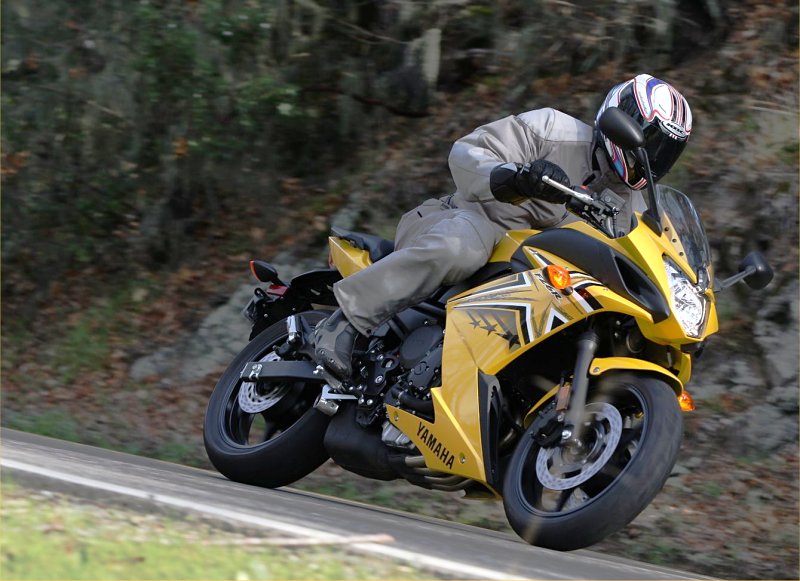
As a bonus to responsible motorcyclists, the relaxed engine speeds and well-muted exhaust tone helps one maintain a low profile pretty much everywhere you ride. And here’s a case in point: three of us came upon a police black-and-white at the side of the road at a potentially embarrassing velocity, but he was aiming his radar gun in the other direction.
Had he heard three four-cylinder sport bikes howling their high-speed defiance through loud aftermarket pipes, he’d likely have traversed his radar gun to the opposite quadrant in plenty of time, if you get my drift. As it was, he didn’t even turn around as the three of us braked at near-stoppie intensity, then grooved on by, eyes flicking to the mirrors in urgent anticipation. He never turned a hair.
As the air force will attest, stealth is a handy thing to have. But our tale of irresponsible enthusiasm suggests something elemental about this bike. It’s fun, it’s adequately fast, it’s somewhat understated, and it’s accessible by riders with a wide range of experience. Oh yeah, and the brakes work.
Yamaha’s little FZ6R revs out with enthusiasm and its six-speed transmission shifts fluently when it reaches the 11,500-rpm redline. Gear ratios are essentially unchanged from those of the FZ6, which seems just about spot on, and the clutch lever is extremely light without being completely numb.
At first acquaintance the bike feels immediately familiar, and it takes hardly any time to come to terms with it. Everything seems to be where it ought to be. All the switches are easy to use, and the instrument panel is clear and tidy. Even the key slot to release the passenger seat is in plain view. I’ve had bikes on loan where I’ve never found that.
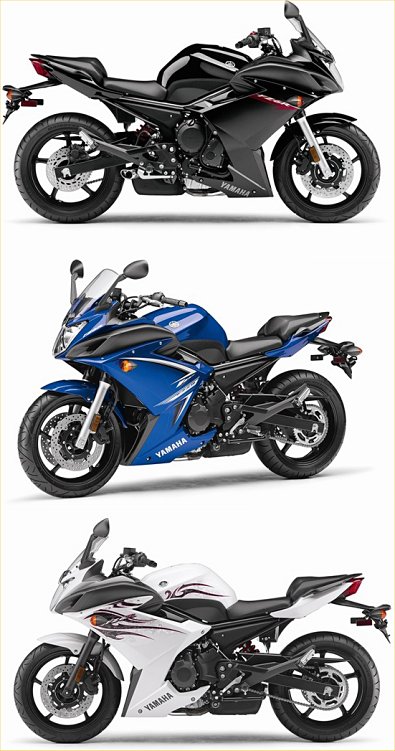
The tube handlebar is at a comfortable level, and boasts a degree of fore-and-aft adjustability (by reversing the mounting clamps, which are offset). So does the seat, which is able to add 0.8-inches to its normal 30.9-inch altitude during an easy exercise that requires just a few bolts to be removed and replaced. Since I am taller than most and have long legs, I tried the new bike in both positions, and found the higher seat to make a remarkable difference considering its modest range of movement.
As one might hope with a broad-spectrum product like the FZ6R, the riding position is comfortable and relatively uncontorted. With foot pegs that are not cinched up like the stirrups on a racehorse, the rider’s knee-bend angle is fairly relaxed. It means that the foot peg feelers will touch down earlier than they might on a full-fledged replica-racer, but you still have to be going pretty hard to do that. Besides, it only happened to me when I switched to a bike that did not have extra rear spring preload dialed in. At 230-pounds, I need that.
Notwithstanding my weight and size (6 feet 5 inches — which makes the bike look comically small under me), I was comfortable throughout the day’s ride. There’s reasonable wind protection behind the fairing, and the retuned 599cc four is remarkably smooth, despite being solidly mounted. Although the FZ6R’s steel chassis makes it a little heavier than its sporty brothers, the bike has light handling and steering, and the smaller rear tire actually seems to ease the initial tip-in transition.
The tube handlebar provides all the leverage you need for quick changes in direction and the bike proves quite flickable at brisk speeds, with no trace of instability from the steering. And at low speeds in urban situations, the large side-to-side steering excursion allows for easy turning in congested surroundings.
It’s a sweet little bike for every circumstance you might ride in, with a pretty decent turn of speed, stable chassis characteristics, and quite reasonable fuel consumption (Yamaha says 43 mpg, average). The sliding pin front brake calipers might not provide the instant bite you find on the R6, but there’s ample braking power when you squeeze the lever hard, with reasonably linear response to increasing pressure.
I also did not find much to complain about from the suspension, despite its less-than-exotic specification and limited adjustability. Indeed, the fork’s performance in light of having no adjustment at all surprised me. I’m clearly well over what the average buyer weighs, particularly since this model is pitched at female riders along with beginner and intermediate-skill males, but there was no excessive dive or poorly damped motion.
All in all, this is a very sensible motorcycle for most people’s realistic needs. It makes one wonder how much of the demand for inverted forks, abundant adjustability, radial brake calipers and all the rest is fashion rather than technology that will be exploited on a large scale by riders.
One of the editors attending this bike’s introduction was fairly insistent about the level of competition out there at a similar price. The Aprilia Shiver, he suggested, is only about $600 more, yet features an inverted fork and radial-mount calipers. He was wrong. The Shiver is listed at $8,999. And besides, it doesn’t have a full fairing.
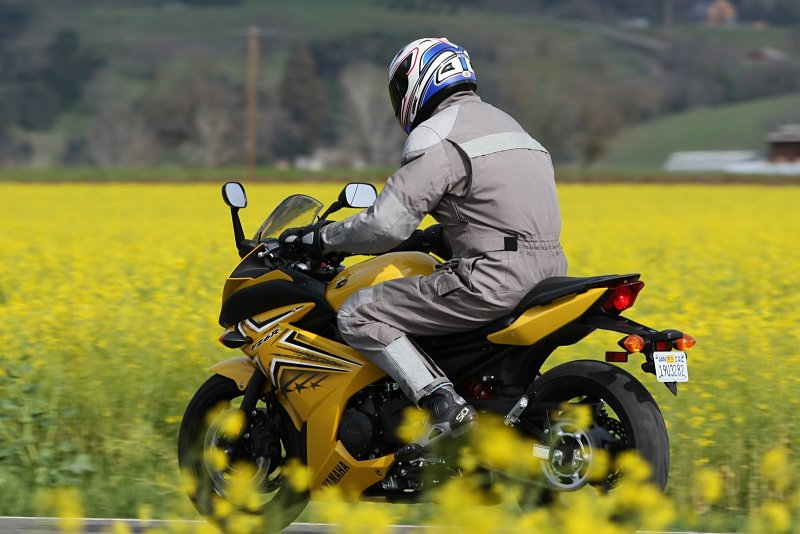
No, the most obvious rivals for the FZ6R are the Kawasaki Ninja 650R (a twin), and the Suzuki SV650SF (a V-twin). If you want four cylinders and a full fairing, you’re really looking at the Suzuki GSX650F, which is stickered at about $7,900 versus the FZ6R’s $7,090. (Or even $6,990, if you’re prepared to take it in black).
It seems to me that Yamaha’s marketing mavens have indeed found a tasty segment among the various categories, and the company’s engineers, in turn, have achieved a good balance between simple function and sophisticated technology. Now all they need are buyers who want to ride rather than pose.
For additional details and specifications on the 2009 Yamaha FZ6R, visit Yamaha’s web site here.





